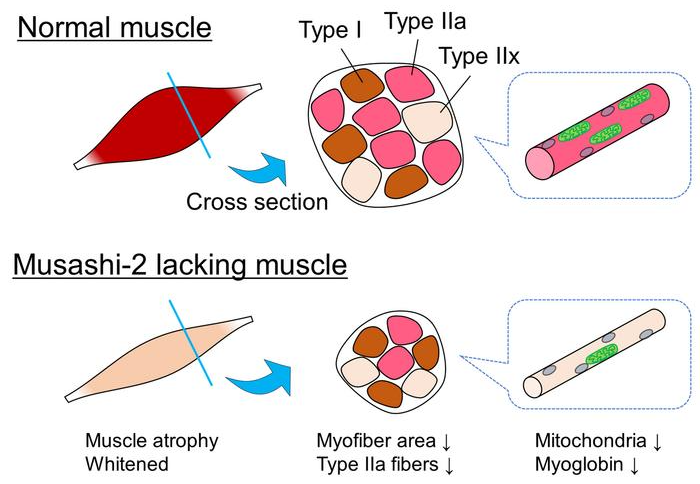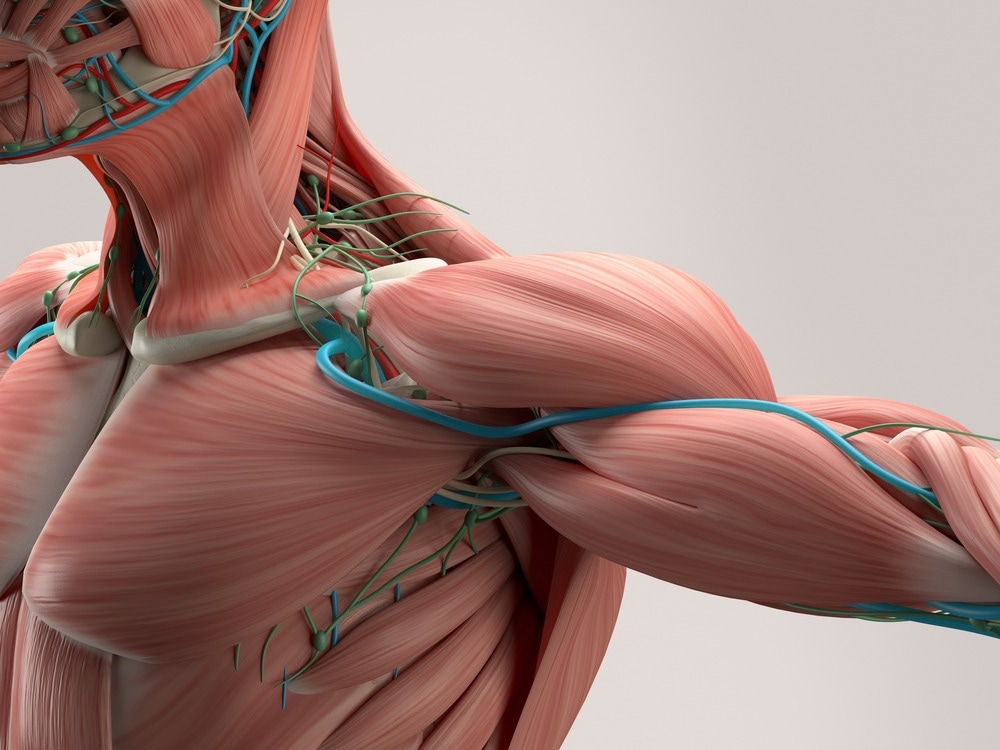Reviewed by Danielle Ellis, B.Sc.Sep 11 2023
Investigators at Tokyo Metropolitan University have demonstrated the pivotal role of the Musashi-2 (Msi2) protein in governing mass and metabolic functions within skeletal muscle. Their investigation involved genetically modified mice lacking the Msi2 gene, revealing a decrease in muscle mass attributed to a lower count of type 2a muscle fibers.
 There is a significant drop in muscle mass due to a loss in type 2a fibers. There is also a decrease in the number of mitochondria and myoglobin, both vital for metabolic processes. Image Credit: Tokyo Metropolitan University
There is a significant drop in muscle mass due to a loss in type 2a fibers. There is also a decrease in the number of mitochondria and myoglobin, both vital for metabolic processes. Image Credit: Tokyo Metropolitan University
Furthermore, reductions in myoglobin and mitochondria levels were observed. As type 2a fibers exhibit heightened responsiveness to training and diseases, understanding their regulatory mechanisms holds promise for the development of innovative therapeutic approaches.
Skeletal muscle fibers are indeed remarkable in their responsiveness. Through training, considerable enhancements can be achieved in terms of muscle mass, strength, and endurance.
Muscle atrophy can occur as a result of prolonged inactivity or the effects of aging. This not only limits mobility but also raises the risk of various health problems. However, researchers have yet to fully understand the mechanisms governing muscle mass and strength regulation.
A team under the leadership of Assistant Professor Yasuro Furuichi at Tokyo Metropolitan University has made a significant breakthrough in solving this puzzle. In their prior research, they identified the presence of Musashi-2 (Msi2), a protein initially identified in nerve cells, within skeletal muscle tissue.
Furthermore, they observed a reduction in Msi2 expression during muscular atrophy. Recognizing the potential for Msi2 to play a more specialized role in muscle fiber development, they opted to conduct a more thorough investigation.
Initially, researchers extracted muscle tissue from mice and employed enzymes to segregate the muscle fibers from nerve tissue, blood vessels, and adipose tissue. Their analysis unequivocally affirmed the expression of Msi2 within the muscle fibers.

Image Credit: Anatomy Image/Shutterstock.com
Additionally, upon examining fibers extracted from calf muscles, they observed the highest levels of Msi2 expression within type 1, or “slow,” fibers characterized by greater endurance but less explosive power compared to their type 2, or “fast,” counterparts.
Furthermore, the researchers investigated mice in which the gene responsible for the Musashi-2 protein had been artificially “knocked out.” In these Msi2 knockout mice, they observed a substantial decrease in calf muscle mass, characterized by a paler appearance and diminished strength.
A microscopic examination of the muscle fiber types revealed that the loss of mass could be attributed to a decrease in the number of type 2a fibers, which are a type of “fast” fiber with some endurance characteristics similar to “slow” fibers. Furthermore, the Msi2 knockout mice had impaired sugar metabolism, which is a common occurrence in diabetes.
A decrease in myoglobin and mitochondria, both critical for cellular energy production, was noted. However, this issue could be rectified by introducing Msi2 expression in “fast” fibers, leading to the restoration of both myoglobin and protein markers essential for mitochondria.
This discovery underscores the pivotal role of Msi2 in governing proteins linked to sugar metabolism and its effective control over the distribution of various fiber types within skeletal muscle tissue.
Type 2a fibers exhibit heightened responsiveness to training and are susceptible to atrophy as individuals age. Therefore, gaining a deeper understanding of their regulation represents a significant stride in pinpointing potential targets for novel therapies aimed at countering muscle deterioration and crafting training routines to enhance muscle strength.
Source:
Journal reference:
Furuichi, Y., et al. (2023). Lack of Musashi‐2 induces type IIa fiber‐dominated muscle atrophy. The FASEB Journal. doi.org/10.1096/fj.202300563r.